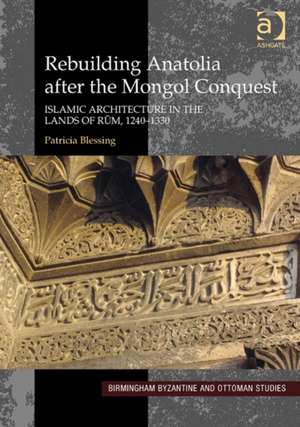Rebuilding Anatolia after the Mongol Conquest: Islamic Architecture in the Lands of Rum, 1240–1330: Birmingham Byzantine and Ottoman Studies
Autor Patricia Blessingen Limba Engleză Hardback – 14 noi 2014
Din seria Birmingham Byzantine and Ottoman Studies
-
 Preț: 388.46 lei
Preț: 388.46 lei -
 Preț: 325.72 lei
Preț: 325.72 lei -
 Preț: 314.62 lei
Preț: 314.62 lei -
 Preț: 381.98 lei
Preț: 381.98 lei -
 Preț: 397.38 lei
Preț: 397.38 lei - 21%
 Preț: 258.06 lei
Preț: 258.06 lei -
 Preț: 399.29 lei
Preț: 399.29 lei - 18%
 Preț: 1009.91 lei
Preț: 1009.91 lei - 17%
 Preț: 242.74 lei
Preț: 242.74 lei -
 Preț: 373.43 lei
Preț: 373.43 lei - 18%
 Preț: 1003.43 lei
Preț: 1003.43 lei - 23%
 Preț: 328.20 lei
Preț: 328.20 lei -
 Preț: 389.38 lei
Preț: 389.38 lei - 25%
 Preț: 324.16 lei
Preț: 324.16 lei -
 Preț: 404.47 lei
Preț: 404.47 lei - 17%
 Preț: 256.87 lei
Preț: 256.87 lei - 25%
 Preț: 324.16 lei
Preț: 324.16 lei -
 Preț: 398.09 lei
Preț: 398.09 lei - 25%
 Preț: 776.84 lei
Preț: 776.84 lei - 25%
 Preț: 834.82 lei
Preț: 834.82 lei - 27%
 Preț: 766.00 lei
Preț: 766.00 lei -
 Preț: 387.91 lei
Preț: 387.91 lei -
 Preț: 311.41 lei
Preț: 311.41 lei -
 Preț: 469.34 lei
Preț: 469.34 lei -
 Preț: 388.72 lei
Preț: 388.72 lei - 30%
 Preț: 771.95 lei
Preț: 771.95 lei -
 Preț: 405.83 lei
Preț: 405.83 lei - 18%
 Preț: 1062.31 lei
Preț: 1062.31 lei - 18%
 Preț: 1004.72 lei
Preț: 1004.72 lei - 30%
 Preț: 873.95 lei
Preț: 873.95 lei -
 Preț: 489.26 lei
Preț: 489.26 lei
Preț: 770.67 lei
Preț vechi: 1106.58 lei
-30% Nou
Puncte Express: 1156
Preț estimativ în valută:
147.47€ • 160.69$ • 124.26£
147.47€ • 160.69$ • 124.26£
Comandă specială
Livrare economică 02-16 aprilie
Doresc să fiu notificat când acest titlu va fi disponibil:
Se trimite...
Preluare comenzi: 021 569.72.76
Specificații
ISBN-13: 9781472424068
ISBN-10: 1472424069
Pagini: 272
Ilustrații: Includes 10 colour and 73 b&w illustrations and 3 maps
Dimensiuni: 174 x 246 x 22 mm
Greutate: 0.81 kg
Ediția:New ed
Editura: Taylor & Francis
Colecția Routledge
Seria Birmingham Byzantine and Ottoman Studies
Locul publicării:Oxford, United Kingdom
ISBN-10: 1472424069
Pagini: 272
Ilustrații: Includes 10 colour and 73 b&w illustrations and 3 maps
Dimensiuni: 174 x 246 x 22 mm
Greutate: 0.81 kg
Ediția:New ed
Editura: Taylor & Francis
Colecția Routledge
Seria Birmingham Byzantine and Ottoman Studies
Locul publicării:Oxford, United Kingdom
Cuprins
Contents: Introduction: reframing the lands of Rum; A capital without royal patronage: Konya (1240-1280); A capital of learning: three madrasas in Sivas (1271-1272); On the Ilkhanid frontier: Erzurum (1280-1320); Small cities in a global moment: Tokat, Amasya, Ankara (1280-1330); Epilogue; Bibliography; Index.
Notă biografică
Patricia Blessing is a staff member at the Stanford Humanities Center and Lecturer, Department of Art and Art History, Stanford University, USA.
Recenzii
"... this book is an eye-opening stroll through the monumental architecture of early Islamic Anatolia. Interweaving the historical and economic forces in play during the later 13th and early 14th centuries, through a study of archives, a rich scholarly literature and a personal knowledge of the land and its remains, Patricia Blessing examines the predominantly local architectural patronage under the Mongols in the main centres of Konya, Sivas, and Erzurum, and the smaller towns of Tokat, Amasya, and Ankara ... this attractive and clearly written book is far more than just an examination of architectural developments in Mongol Anatolia, but also a study in history that probes back into the Seljuk period and forwards into Ottoman times."
- Professor Paul Arthur (Universita del Salento, Italy) in the journal of the Society for Medieval Archaeology
- Professor Paul Arthur (Universita del Salento, Italy) in the journal of the Society for Medieval Archaeology
Descriere
Beginning with the Mongol conquest of Anatolia in 1243, and ending with the demise of the Ilkhanid Empire in the 1330s, this book considers how the integration of Anatolia into the Mongol world system transformed architecture and patronage in this frontier region. Blessing considers the monuments built during this period alongside written sources in Arabic, Persian and Turkish. In doing so, she untangles the narratives of architecture, history and religion and provides a broader understanding of the interaction of identities in the medieval Middle East.
